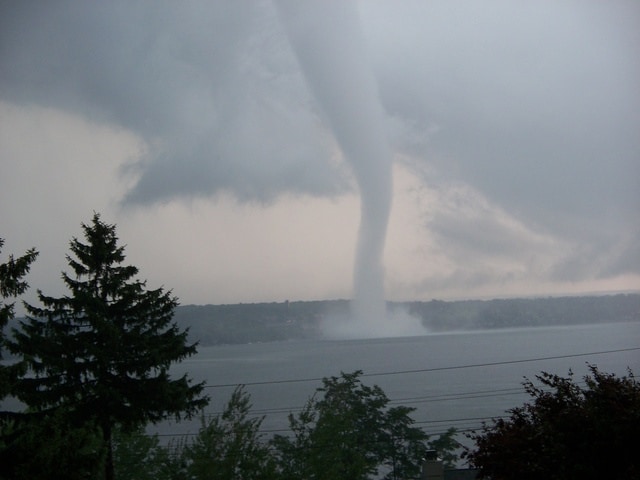
A tornado is a strong, turbulent column of air, moving fast and keeping in contact with the earth’s surface and a vertically formed cloud carrying dense water vapors, called the cumulonimbus cloud. Commonly, the tornadoes are shaped like a funnel, but the shape and structure can vary according to the climatic conditions. The bottom end of the vortex is surrounded by a cloud of dust and debris. Tornadoes are formed from the extremely large thunderstorms called supercells.
Tornadoes can be very destructive in nature with their speed ranging from 110mph to 300mph and can last to about 1-2 hours or 4 hours, in extreme cases, and can be as tall as 75 feet. Tornadoes also occasionally occur in south-central and eastern Asia, northern and east-central South America, Africa, North West and South East Europe, West and South East Australia, and New Zealand. Most commonly, tornadoes are observed to occur in the Tornado Alley, ranging from the states of Texas to Iowa, in the United States. Except Antarctica, tornadoes can occur anywhere.
Types of Tornadoes
There are various types of tornadoes and they can characterized according to the level of damage they can cause. Fujita or Enhanced Fujita(EF) scale scale is a reference scale to characterize the tornado according to the magnitude of the destruction. EF0 being the least destructive and EF6 being the most extreme.
There are different types of tornadoes which are observed all over the world. Some of them are:
Multiple Vortex Tornado
In such cases, there are two or more spinning columns of air around a common center. These vortices often create small areas of heavier damage along the main tornado path. The vortices themselves rotate in the peripheral region of the eye of the tornado.

Waterspout Tornado
It is tornado that is formed over a water body, usually an ocean or sea.They are similar to the mesocyclonic thunderstorm tornadoes but are formed over a water body. A waterspout is not a destructive tornado as it spans itself over less than 2 km. Tornadoes of these type cause damage that tends to be EF2 or less.
Landspout Tornado
These are similar to waterspout tornadoes in terms of relative weakness, short lifespan, and a small, smooth condensation funnel which often does not reach the surface. There is no rotating updraft – the spinning motion originates near the ground. They are usually weaker than normal tornadoes but can create winds which can cause serious damage.
Dust-Devil Tornado
They are similar to the normal tornadoes, of vertically rotating column of air. But they occur under clean skies and are very weak. They form when a strong hot updraft is formed near the ground on a hot day. A Dust-Devil tornado occurs when the sun heats dry land surfaces forming a twisting column of air. These types of tornadoes are commonly known as willy willy in Australia.
Gustnado Tornado
This type of tornado has a gust like vertical updraft of air. They are not connected with a cloud base. They are formed when cold dry updraft of air mixes with the moist cool air which is stationary resulting in a rolling effect. A Gustnado is short-lived and lasts from few seconds to minutes.
No comments:
Post a Comment